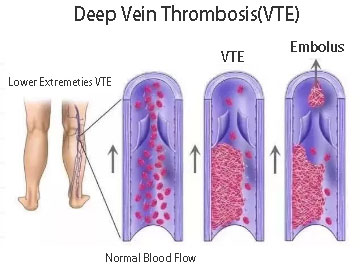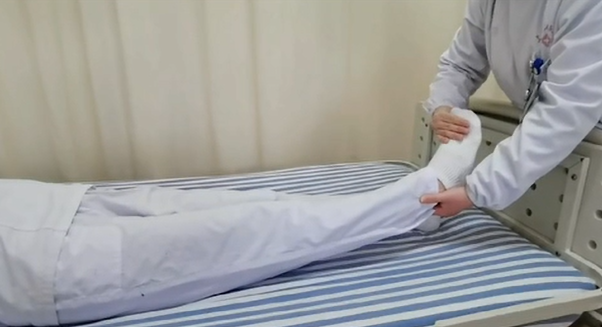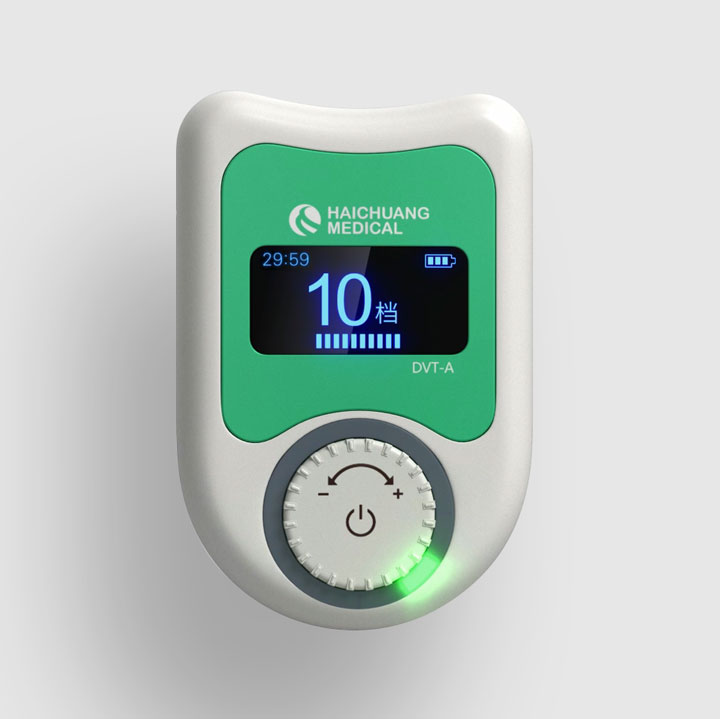The human veins are divided into superficial veins and deep veins. The so-called superficial veins refer to the blood vessels that run in the tissues under the skin and can be seen with the naked eye under normal circumstances. Usually, doctors and nurses inject, infuse, and take blood in superficial veins.
But the deep veins are invisible, they are deep in the skin, sometimes between the muscles. As the name implies, deep vein thrombosis is a blood clot that forms in a deep vein.
1. How does deep vein thrombosis form?
There are three main causes of deep vein thrombosis: damage to the vessel wall, slow blood flow, and increased blood viscosity.
The inner wall of the human blood vessel itself is very smooth. When the blood vessel wall is damaged due to trauma and other reasons, coupled with long-term bed rest, the disease needs to stop activities, the blood flow will slow down; at the same time, stress, tumors, inflammatory reactions, etc. cause blood viscosity. As the temperature increases, many substances in the blood will deposit on the injured part of the blood vessel wall, and accumulate more and more, forming a thrombus.
2. What are the symptoms of deep vein thrombosis?
- Blood clots can occur anywhere in the body:
- The generation of blood vessels in the brain leads to cerebral infarction;
- Myocardial infarction occurs when the coronary artery arises;
- Pulmonary embolism (PE) is caused by the development of blood vessels in the lungs;
- Deep vein thrombosis (DVT) occurs in lower extremity blood vessels, among which lower extremity is the most common.
More than half of the patients had no symptoms; the thrombus that occurred in the lower extremities mainly had symptoms such as calf swelling, pain, tenderness, and warm skin.

Once the thrombus in the lower extremities falls off and drifts with the blood flow, it can also lead to pulmonary embolism, myocardial infarction, cerebral infarction, etc., chest pain, dyspnea, hemoptysis, syncope and other symptoms, and even sudden death, which is a serious threat to life.
Therefore, the prevention of deep vein thrombosis should be emphasized.
3. What are the causes of deep vein thrombosis?
(1) Patients who recently underwent major surgery, trauma, fracture, etc. and need bed rest;
(2) Sitting still and inactive for a long time, such as during long-distance travel, taking an airplane or train or sitting in front of a computer for a long time, will increase the risk of blood clots;
(3) For women during pregnancy and postpartum, taking oral contraceptives will increase the risk of blood clots;
(4) Old age, obesity, family history, long-term smoking, etc. will increase the risk of thrombosis;
(5) In addition, patients with malignant tumors and those receiving cancer treatment (hormone therapy, chemotherapy or radiotherapy) are also high-risk groups for thrombosis.
4. How to prevent deep vein thrombosis before and after surgery?
Patients need to learn to perform lower extremity exercises on the bed to prevent blood clots. There are four sessions of lower body exercises, let’s learn together!
(1) Ankle pump exercise: You can take a supine position or a sitting position, first forcefully hook your feet upwards, and hold for 10 seconds; then forcefully stretch your toes downwards, hold for 10 seconds, then forcefully upward hook your feet for 10 seconds, repeat ( pause for a moment).
(2) Rotation of the ankle joint: take the supine or sitting position, first rotate the ankle joint 10 times clockwise, then 10 times counterclockwise, and then continue to rotate 10 times clockwise, repeat.
(3) Quadriceps exercise: Take the supine position, make the popliteal fossa as close to the bed as possible, hold for 10 seconds, then relax the knee, hold for 10 seconds, then bring the popliteal fossa close to the bed, repeat.
(4) Hip and knee exercise: Take the supine position, first bend the knee and thigh, hold for 5 seconds, then straighten the leg, then bend the knee and thigh, repeat.
It is recommended that patients learn lower extremity exercises before surgery to facilitate postoperative exercise. They practice 3 groups a day, 15 times in each group.
*If in doubt, you can ask the nurse and your attending physician.
5. After surgery
The period of bed rest for 1 to 2 days after surgery is a period of high incidence of deep vein thrombosis. The following 6 points need to be paid attention to:
(1) Early exercise: The period of bed rest for 1 to 2 days after surgery is a period with a high incidence of deep vein thrombosis. Therefore, after waking up from the anesthesia, the patient should gradually start to exercise the lower limbs. Early exercise can help promote the smooth flow of venous blood in the lower limbs, thereby preventing the occurrence of thrombus.
(2) Getting out of bed early is a favorable measure to prevent deep vein thrombosis. Getting out of bed can promote blood circulation throughout the body and speed up blood flow, thereby preventing the occurrence of thrombus.
- Firstly, the nurse will instruct the patient to sit on the edge of the bed with legs drooping;
- After the patient gets used to it and feels no dizziness, palpitation and other symptoms, you can get down and stand beside the bed, and hold the bed by hand to ensure safety;
- After the patient gets used to it, he can start walking gradually.
*In order to ensure the safety of patients, family members are requested to go to the ground only when they are nearby. If you feel dizzy, have weak legs, palpitation, and other discomforts, please inform the medical staff immediately. Be sure to pay attention: patients need to gradually increase the amount of activity according to their own physical strength.
(3) During postoperative bed rest, medical staff will also provide patients with intermittent inflatable pressure pumps or new ENMS equipment (Refer to our DVT-A) to help prevent the formation of thrombus.
(4) Patients can also use elastic stockings (elastic stockings, not stockings), which are divided into various types due to the difference in pressure gradient. Please use them under the guidance of a doctor.
(5) The doctor in charge of the patient will also give injection or oral anticoagulant drugs according to the specific situation, please use them under the guidance of the doctor.
(6) Finally, during postoperative bed rest, patients and their family members need to pay attention to the following points:
a. After the operation, family members must not massage or knead the legs of the patient to prevent the formation of small thromboses. After massage, the thrombus will fall off and cause embolism in the heart, brain, lungs and other parts.
b. Try not to sit cross-legged or cross-legged on the bed, and avoid placing pillows under the popliteal fossa. These actions will affect the venous return of the lower extremities, thereby increasing the risk of thrombosis.
c. It is recommended to drink a small amount of water frequently, about 2000ml per day. Drinking more water will not only help to dilute the blood, improve the blood condition, and promote blood circulation, but also dilute the sputum and help expel phlegm.
d. Patients can soak their feet in warm water every day to promote blood flow back to the lower limbs, and be careful to avoid burns! (*Note: If the patient has varicose veins or has symptoms of thrombus such as leg swelling and pain, please do not soak the feet to avoid the thrombus falling off.)
Note: During the postoperative recovery period, if the patient feels the skin color change, swelling, pain, etc. of the lower limbs, please inform the medical staff in time.

6. Prevention of deep vein thrombosis
Deep vein thrombosis does not only occur in postoperative patients, it can occur at any age and at any time, so developing a healthy lifestyle is an effective prevention method!
For information about DVT prevention equipment using ENMS technology, you can click the button below to inquire.
Neuromuscular Electrical Stimulator DVT-A
Applicable for lower limb deep vein thrombosis prevention

